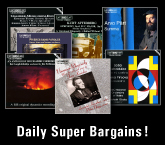Richard Festinger’s finely crafted music contains a disarmingly attractive range of expressive characters, from contrapuntally driven dialogue to coloristic orchestration to dry wit. A protégé of influential modernist composer Andrew Imbrie, Festinger also has a background as jazz guitarist and studied with legendary vibraphonist Gary Burton and trumpeter Herb Pomeroy. These influences seem to have manifested themselves less in a stylistic footprint, though Festinger’s chosen vocabulary certainly identifies itself as late Modernism, and more in the kind of rigorous approach to pitch relationships that one would find in both disciplines. Throughout there is a cogent logic to how Festinger develops ideas that retains an organic sense of evolution, as if the musical ideas are allowed to stretch out and find their own way. His ear for instrumental texture is apparent in the varying sonic profiles of the works for different ensembles included in this collection of his chamber works.
Invocation for reed quintet was composed in 1991 for the Dutch based Calefax Reed Ensemble. The work begins with an introspective opening, with the alto saxophone and clarinet alternating fluid, inquisitive phrases. The other three instruments join gradually, spinning lithe, delicate lines in an accumulating texture. An energetic section follows with darting gestures and punctuating affirmations, reinforcing the contrapuntal interplay that lies at the heart of its conception. Lush chords provide the backdrop for a poignant oboe solo midway through the work, which navigates through vigorous and subdued passages before closing with a dramatic phrase in unison rhythm.
The bass clarinet and cello duo, To a Pilgrim, is dedicated to Festinger’s influential mentor, Andrew Imbrie. Not unlike Invocation, Festinger animates instrumental characters through a lively dialogue that is made all the more transparent by the piece’s lean instrumentation. In the piece’s opening, we hear the two instruments carving out their respective roles, with the cello particularly staking out wide registral and timbral territory with trills, tremolos, and harmonics. The bass clarinet traces sloping figures, occasionally sounding more fragmentary utterances. In a quasi-hocketed passage in the middle of the piece, the two instruments ricochet off each other with off-kilter syncopated bursts before embarking on a series of brief canons exploring strict intervallic relationships. The work returns to the primordial, murky harmonies from which it began.
Hidden Spring, written for the mixed ensemble group Cygnus (flute/alto flute, oboe/English horn, violin, cello, guitar, and guitar/mandolin), allows its unique instrumentation to lead the piece’s evolution, reveling in its shimmering textures and hybrid timbral possibilities. Festinger draws on his background as a guitarist to write quite effectively for the plucked strings pairing, often intertwining long lines between the two to create a kind of spatialized, expanded guitar. The two winds and two strings are also often paired, lending the work quasi-antiphonal moments. If Invocation and To a Pilgrim were primarily driven by line, counterpoint, and dialogue, Hidden Spring seems to prioritize color, mining arrivals and instrumental combinations for their unique sonic characteristics. Brilliant passagework and punctuated splashes of harmony enliven the piece as it ebbs and flows between mischievous dexterity and thoughtful reflection.
Il était une fois… for piano trio was written for the 50th anniversary of the impactful Boston based Collage New Music. Two annunciatory gestures open the “Moderato,” a sonata form movement that toggles between restless interplay between the instruments, and pathos-laden passages featuring the string instruments in turn. “Missing material” from the recapitulation of the exposition in the first movement finds its way into the “Andante,” serving as its germinal seed. String phrases develop a rhetorical architecture as the piano encircles their intensification with chordal commentary. A delicate violin and cello passage acts as the bridge to a mournfully lyrical section over watery piano accompaniment. The trio’s final “Allegro” begins with frisky, charged material before floating into a more settled section with fluid piano arpeggios and a string line in unison rhythm. The movement progresses as a push and pull between these characters, angular versus rolling.
The short three movement work for woodwind quintet, Windsongs, is the lightest piece on the recording, playfully utilizing the virtuosic capacities of the San Francisco based Windscape, the group for whom the piece was written. “Presto energico” features a moto perpetuo string of swooping sixteenth notes that pass through the instruments of the ensemble, colored and commented upon with brief sustains, melodic fragments, and jaunty interjections. The velvety chord voicings that dominate the second movement “Lento” appear as sound color objects, inflected by subtle appoggiatura type figures and sinewy, connective lines. The flute first breaks the hypnotic texture with nervous bird call fragments before the oboe plays a heroic cadenza and leading to a haunting final sonority. The final “Allegro” further reinforces the work’s quirky character, featuring darting figures, anxious trills, and jumpy accents.
– Dan Lippel
Extra material for download







